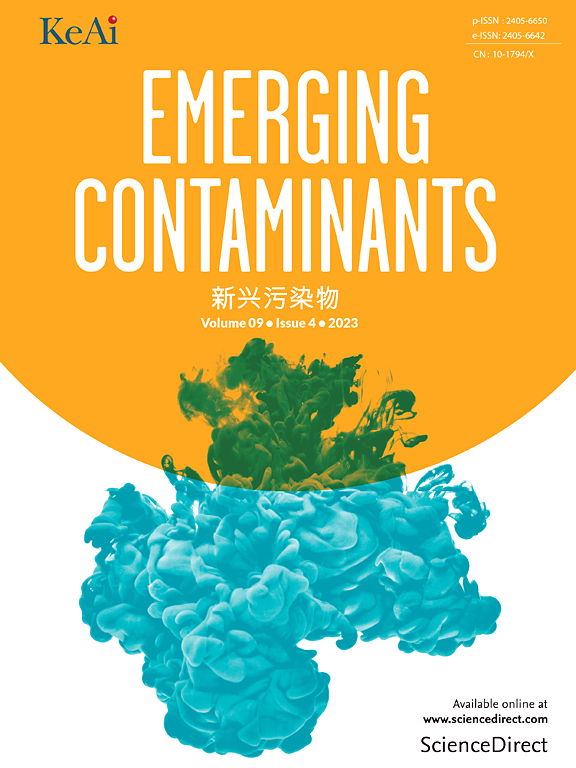Per- and polyfluoroalkyl substances (PFASs) in crayfish (Procambarus clarkii) from Hubei Province, China: exposure, risk assessment and bioaccumulation
IF 6.9
2区 环境科学与生态学
Q1 ENVIRONMENTAL SCIENCES
引用次数: 0
Abstract
This study investigated the exposure levels of PFASs in crayfish sourced from Hubei Province, assessed the health and safety risks associated with consuming crayfish, and explored the bioaccumulation of PFASs in sediment affecting crayfish. The results showed that 10 types of PFASs were detected in all crayfish samples, with a detection rate of 100 %, and the concentration range of ∑PFASs was 0.90–2.67 μg/kg ww, with perfluorooctanoic acid (PFOA) and perfluorododecanoic acid (PFDoDA) being the most abundant compounds. In sediment samples, 8 types of PFASs were detected with a 100 % detection rate, and perfluorobutyric acid (PFBA) and perfluorooctanesulfonic acid (PFOS) were found to be the most abundant. The hazard index (HI) for PFASs in crayfish was significantly larger than 1, and Monte Carlo simulation results indicated that exposure to PFASs through consumption of the edible portions of crayfish may pose a significant risk to human health. Spearman correlation analysis revealed a significant correlation (p < 0.01) between the concentrations of perfluorononanoic acid (PFNA), perfluorobutanesulfonic acid (PFBS), and PFOS in crayfish and their corresponding compounds in sediments. Additionally, the biological-sediment accumulation factor (BSAF) values for PFOA and PFNA exceeded 10, indicating a certain potential for bioaccumulation.
中国湖北省克氏原螯虾(Procambarus clarkii)中的全氟和多氟烷基物质(PFASs):暴露、风险评估和生物积累
本研究调查了湖北产小龙虾中PFASs的暴露水平,评估了食用小龙虾的健康和安全风险,并探讨了PFASs在沉积物中的生物积累对小龙虾的影响。结果表明,所有小龙虾样品中均检出10种PFASs,检出率为100%,∑PFASs浓度范围为0.90 ~ 2.67 μg/kg ww,其中以全氟辛酸(PFOA)和全氟十二烷酸(PFDoDA)含量最高。在沉积物样品中,共检出8种PFASs,检出率为100%,其中全氟丁酸(PFBA)和全氟辛烷磺酸(PFOS)含量最高。小龙虾中PFASs的危害指数(HI)显著大于1,蒙特卡罗模拟结果表明,通过食用小龙虾的可食用部分暴露于PFASs可能对人体健康造成重大风险。Spearman相关分析显示,小龙虾体内的全氟壬烷酸(PFNA)、全氟丁烷磺酸(PFBS)和全氟辛烷磺酸(PFOS)与沉积物中相应化合物的浓度呈极显著相关(p < 0.01)。PFOA和PFNA的生物-沉积物积累因子(BSAF)均大于10,具有一定的生物积累潜力。
本文章由计算机程序翻译,如有差异,请以英文原文为准。
求助全文
约1分钟内获得全文
求助全文
来源期刊

Emerging Contaminants
Medicine-Public Health, Environmental and Occupational Health
CiteScore
10.00
自引率
6.70%
发文量
35
审稿时长
44 days
期刊介绍:
Emerging Contaminants is an outlet for world-leading research addressing problems associated with environmental contamination caused by emerging contaminants and their solutions. Emerging contaminants are defined as chemicals that are not currently (or have been only recently) regulated and about which there exist concerns regarding their impact on human or ecological health. Examples of emerging contaminants include disinfection by-products, pharmaceutical and personal care products, persistent organic chemicals, and mercury etc. as well as their degradation products. We encourage papers addressing science that facilitates greater understanding of the nature, extent, and impacts of the presence of emerging contaminants in the environment; technology that exploits original principles to reduce and control their environmental presence; as well as the development, implementation and efficacy of national and international policies to protect human health and the environment from emerging contaminants.
 求助内容:
求助内容: 应助结果提醒方式:
应助结果提醒方式:


